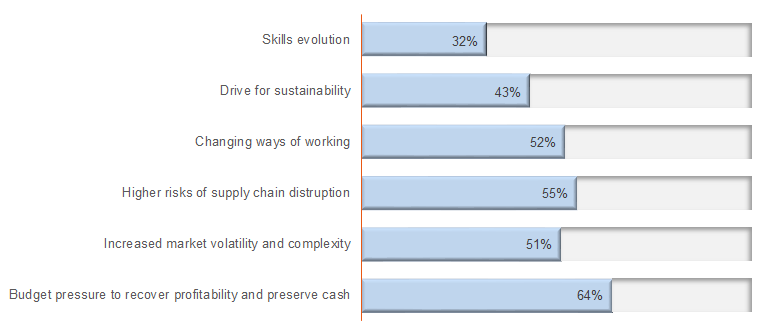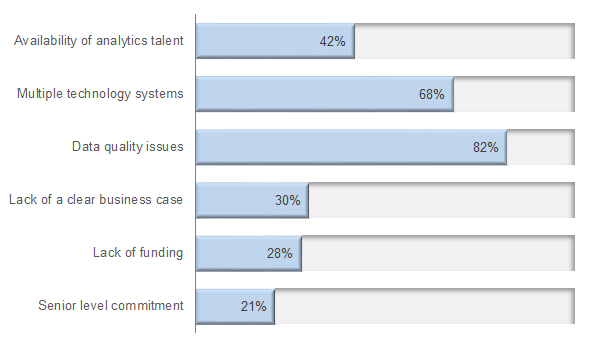
Procurement Analytics was the focus of CASME’s latest joint webinar, with alliance partners The Smart Cube. This webinar set out to explore how modern analytics tools and techniques can help to unlock deeper, more actionable data insights, supporting Procurement with better decision-making and greater returns.
Graham Crawshaw, Content Director at CASME, and Omer Abdullah, Co-Founder at The Smart Cube, spent an hour sharing their experiences with a global audience of 250 procurement professionals.
The results of the audience polls indicate that the use of Procurement Analytics is in its infancy, and most procurement teams would benefit from applying modern tools and techniques that go beyond spend analysis. However, before advancing to this next stage, a few challenges need to be addressed first.
Impacts on the business
Graham and Omer began by discussing the influence of an evolving business environment and introduced an interactive audience poll to help set the scene. The poll results show that for 64% of the webinar audience, budget pressure to recover profitability and preserve cash is a major impact on future strategy.
What are your top 3 impacts on the business environment?

Other significant impacts include higher risks of supply chain disruption (selected by 55%) and changing ways of working (52%). From many previous discussions with members, CASME has identified a significant challenge that exists in effectively managing working capital and settling invoices to meet the needs of the company and its suppliers; a problem that has been further exacerbated by the pandemic.
What is Procurement Analytics?
Although the answer might appear to be as straightforward as ‘the evaluation of spend data’, the discussions confirmed that the activities involved in Procurement Analytics are much more complex than those associated with spend analysis alone. Procurement Analytics, in its true sense, extends right across the category management lifecycle and concerns the process of turning procurement data into actionable insights that can help address priorities within the procurement function.
Activities under the scope of Procurement Analytics include:
- Base spend visibility
- Specification rationalisation
- Make vs Buy modelling
- Savings opportunity assessment
- Predictive demand planning and forecasting
- Should-cost modelling
- RFx analysis
- Supplier scorecards
- Tail spend optimisation
- Supplier risk analytics
- Commodity price forecast
- Purchase price variance analysis
- Payment terms analytics
- Contract management analytics.
How mature is the use of Procurement Analytics?
Having explained what constitutes Procurement Analytics, the second poll attempted to gauge the extent of its maturity usage level within those organisations attending the webinar.
To what extent is Procurement Analytics established in your department?

Most of the audience (29%) is limited to applying spend analytics; this is typically the level at which Procurement starts when it begins to evaluate the only accessible data. Then, as Procurement progresses along the analytics journey, it becomes possible to do more advanced work at a data management level.
At this next stage, represented by 21% of the audience, Procurement creates a data repository or master dataset, focuses on standardisation and has checks and validation in place.
A quarter (25%) of the audience apply procurement analytics tools at the more progressive descriptive level. This includes real-time reporting, use of basic dashboards and performance measurement.
A smaller percentage (16%) have implemented an advanced level of diagnostic analytics. This includes incorporating external and internal benchmarking into the analytics, elements of risk analytics and root-cause analysis.
Not surprisingly, less than 10% of the audience, those most mature in their procurement analytics activities, engage the highest level of predictive and prescriptive analytics. This uses forecasting and assessing scenarios for action planning and running simulation modelling.
Drawbacks to implementation
So, what is limiting the application of Procurement Analytics? Organisations understand that analytics can be powerful but are constrained by multiple issues. These may include:
- Data
- Lack of availability and inability to access the required data
- Poor data quality – issues of inconsistent supplier naming
- Technology
- Multiple ERP systems, different versions and generations
- Lack of integration
- Process
- Insufficient funding
- Lack of a business case to justify investment
- Talent
- Shortage of relevant skills to perform analytics
- Lack of available talent.
Addressing the roadblocks
In the final webinar poll, participants responded by highlighting the various reasons why greater use of Procurement Analytics is a challenge.
What are the main roadblocks to Procurement Analytics in your organisation?

Data quality issues are a significant factor, widespread among 82% of the audience. This might be due to a lack of sufficient detail included on purchase orders, inaccuracies when setting up part numbers or product descriptions, or inconsistencies when setting up suppliers – the classic example being the setting up of logistics company Kuehne and Nagel; whether to include the umlaut, include the legal identifier AG (Aktiengesellschaft), or shorten to K+N. One organisation famously reported the company was set up 30 times in their ledgers, all with different spelling combinations, making it difficult to accurately review the logistics spend with so many data input variants representing the same supplier.
The use of multiple technology systems was the second most popular reason for the lack of procurement analytics application (68% of audience votes), and the scarcity of personnel with analytics talent was an issue for 42%.
10 consideration points for successful implementation
To conclude the webinar discussion, Omer and Graham shared a 10-point checklist containing the foundations for success.
When implementing Procurement Analytics, remember to:
Assess technical readiness
Assess business readiness
Identify the pain points, business objectives, challenges and risks
Set up a well-defined data governance and security management process to ensure data is accurate and secure
Ensure GDPR compliance
Define SLAs with respect to timelines, quality, etc.
Start small and do it effectively; deploy the analytics strategy in phases, evaluating success at regular intervals
Focus on value creation and not just cost savings
Engage with an expert who can help to manage the entire process at a holistic level and give insight into the best practices followed in the market
Seek regular feedback from end users.
Click to listen to the discussions and watch the webinar in its entirety.
Back to News



